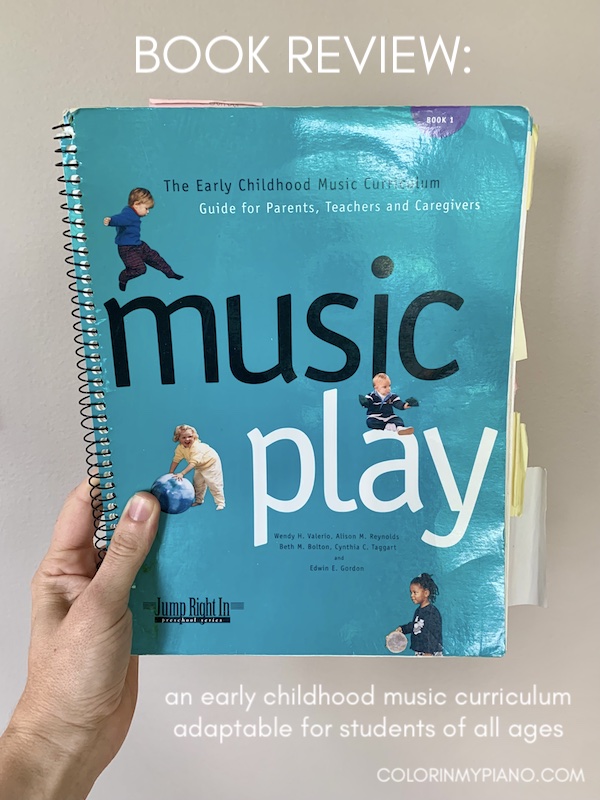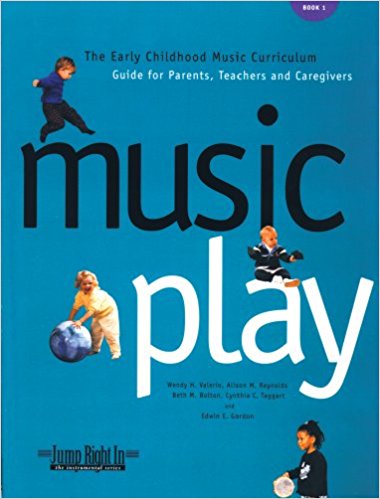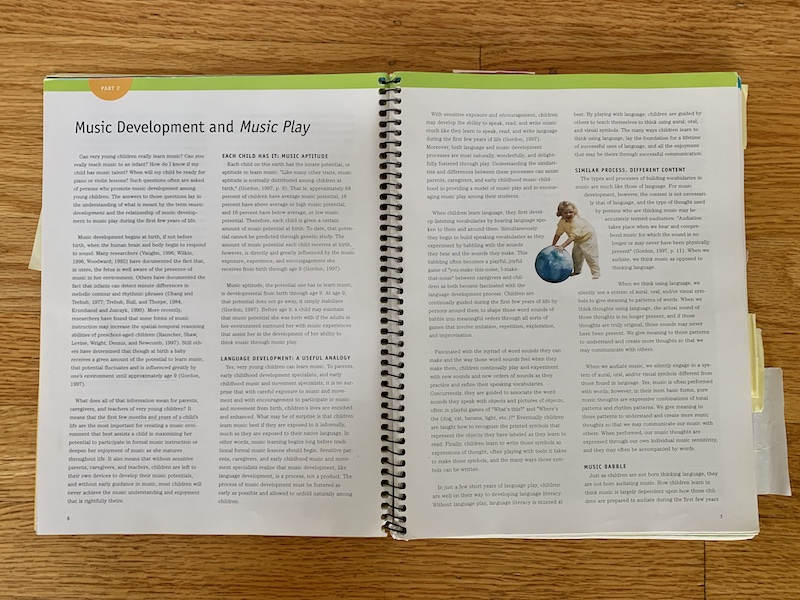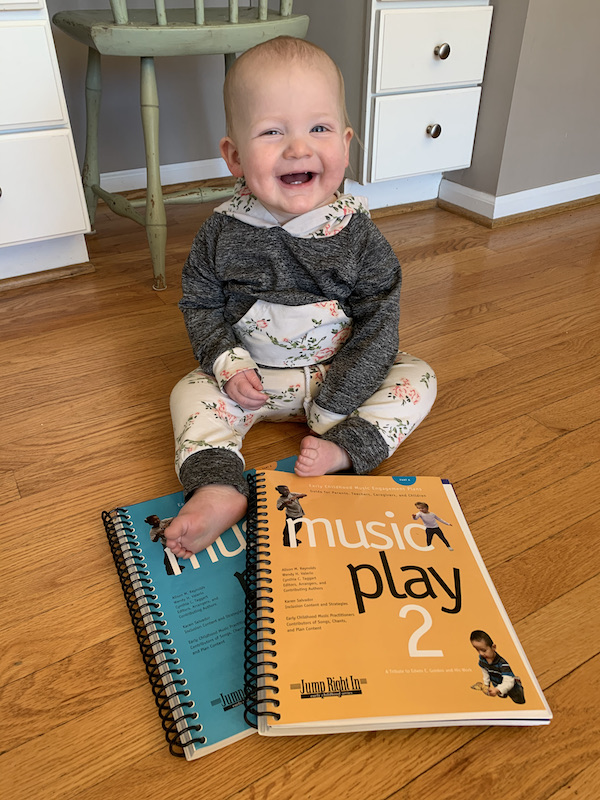
In recent conversations with a couple of piano teachers, I was asked there is a review available here on my blog about Music Play, a book I like to draw from for movement and ear/audiation activities with my young daughter and my piano students. Look no further, friends — here’s my full review!
First Look

Music Play is a Music Learning Theory (MLT) based curriculum intended for early childhood music (ECM) programs. It is the curriculum of choice for those who undergo certification training in ECM through the Gordon Institute for Music Learning. I took Level 1 for early childhood music back in 2017 (and Level 1 for piano in 2016), and would recommend these training courses to anyone interested. Even better, I suggest joining GIML as a way to get started with learning about MLT and gain access to their occasional webinars!
(Unfamiliar with MLT? Check out my blog post called, What is Music Learning Theory, exactly?.)
The authors of Music Play include big names in the MLT world such as Wendy H. Valerio, Alison M. Reynolds, Beth M. Bolton, and Cynthia C. Taggart — as well as Dr. Edwin E. Gordon himself. The book was published in 1998. This curriculum was created as part of the Jump Right In curriculum, rounding out the offerings for teachers of babies, toddlers, and preschool children.
Organization
The first third of the book is devoted to discussing music development and how teachers can go about structuring an early childhood music program. This lengthy reading section is worth the time to read and study. It contains a helpful overview of Gordon’s types and stages of “Preparatory Audiation” (read more about audiation here), which sets an important foundation for understanding how to use the songs, chants, and activity pages that follow.
(In case you are wondering, a chant is like a song except it is just spoken rhythmically!)

The rest of the book contains activity pages that correspond to each presented song or chant. There are four main sections:
- Songs without words
- Chants without words
- Songs with words
- Chants with words
Gordon was of the opinion that young children already get so much language exposure, so he recommended music teachers use songs and chants that do not have words to help naturally encourage students to focus on the music itself. MLT practitioners today tend to agree with this, but many do nevertheless judiciously incorporate certain songs and chants that do have words. This is why you see the book organized the way it is.

The Music Play book comes with recordings of the songs/chants on CD. You can also buy the MP3s on the GIA website here. Listening to these tracks is a great way for teachers to familiarize themselves with the songs and chants.
The Songs and Chants from Music Play
On a typical song/chant page, you’ll see the notated song or chant, information about the music content (the tonality/meter), information about the movement content (what kind of movement is the children being presented with), and suggested materials or props.
Below that, you’ll see three sections of activities according to which type of preparatory audiation the child shows readiness for: Acculturation, Imitation, or Assimilation (as discussed in the beginning of the book). These activity ideas can be used exactly or can be adapted according to your teaching style.

Generally, MLT practitioners tend to use a “whole-part-whole” structure when using a song or chant for an activity. They begin by performing the song or chant a few times for the students to listen to as they move. Then, the teacher will spend time with patterns — either tonal patterns or rhythm patterns — so students get used to hearing those. Then, the teacher will return to the original song or chant once again. The idea is that music content is always presented in context. Students will gain greater understanding of the “parts” of music when it is firmly embedded in the context of a “whole” (meaning, the tonality/meter of the song or chant).
For a typical semester (let’s say, 10 weeks in length), an early childhood music teacher would likely select at least a dozen songs/chants to use during that time. The lesson plan for each class ideally incorporates a nice variety of tonalities (major, minor, mixolydian, dorian, etc.), meters (duple, triple, combined, even, uneven, etc.) and movements (experiencing flow, weight, space, and time). The teacher is always watching student responses in order to track their musical development and respond accordingly according to the stages they observe. Many MLT teachers enjoy incorporating props into the activities, such as scarves (find some similar to the ones I have here or here), mini maracas (I love these!), or shakers.
I hope that gives you somewhat of a picture of how this curriculum is intended for use in early childhood music settings!
PS: Please note that this blog post contains Amazon affiliate links. Thanks so much for supporting my blog!
Adapting “Music Play” with Older Students
In past blog posts (such as this one), I’ve mentioned I like to modify the Music Play activities for use with my piano students. I find the activities work great for any preschooler or young five-year-old, as well as for older students especially for during our “Piano Party” group classes. The idea is to take the song or chant and use it in the manner that an MLT school classroom music educator would. I always retain the whole-part-whole structure for the activity, but instead of using the early childhood patterns described in the book, I use patterns more appropriate for their musical age (for example, tonal patterns involving tonic, dominant, and more; and rhythm patterns involving macrobeats, microbeats, divisions, and more).
There are LOTS of places to source good songs and chants in a variety of tonalities/meters for your teaching (perhaps this would be a good topic for a future blog post!), but the Music Play book is full of ones that are always hits with students. Plus, the accompanying activity ideas are so helpful as inspiration for getting students moving, listening, and thinking.
In short: if you are interested in doing more movement and audiation (aural comprehension) activities with your students, Music Play might be a great resource for you.
My Personal Favs
In case you decide to purchase the Music Play book, I’d like to share with you a list of my favorite songs and chants. Perhaps you’d like to earmark these pages and learn these first!
Here they are: 50, 56, 64, 66, 69, 71, 72, 74, 78, 80, 92, 94, 113, 115, and 119.
A Note about Music Play 2
Earlier this year, GIA released the long awaited Music Play 2! I ordered it soon after it came out and have been enjoying having some new songs/chants to try with my daughter, Aria.

As you can see in the photo above, Music Play 2 is MANY more pages than the original Music Play. Music Play 2 comes in two volumes, Part A (264 pages) and Part B (230 pages), while Music Play is a single volume with 140 pages.
My recommendation is NOT to buy Music Play 2 unless you already have the original Music Play book and are ready for more songs/chants and activities. Music Play 2 assumes you already have familiarity with teaching MLT-based early childhood music. It does not re-explain the essential information provided in the original Music Play book.
If you ARE ready for Music Play 2, you can order it directly from GIA (click here), Amazon (click here), or your favorite bookseller. The bundle containing both the Part A and the Part B books runs around $85 USD. Rumor is that recordings will eventually be available for the songs and chants in Music Play 2, but there is no estimate for when that might be.
Bottom Line
Music Play is an excellent and affordable curriculum to use for your early childhood music program or preschool piano students. It also is adaptable for older students as a great entry point for teachers interested in incorporating the types of activities MLT practitioners use in their private studios or music classrooms. I give it five stars!
Order Music Play directly from GIA Publications (click here), Amazon (click here), or your favorite bookseller. It’s available for about $45 USD.
Thanks for reading my review!
Your turn: Do you teach early childhood music or preschool piano? I’d love to hear about your favorite resources and curriculum to draw from! Please leave a comment.


Hi! Some of the books I really enjoy using with my preschool kids are:
1. Classroom Music for Little Mozarts https://www.alfred.com/classroom-music-for-little-mozarts-curriculum-book-1-cd/p/00-22023/
This one is great for music and movement.
2. My First Piano Adventure https://www.alfred.com/classroom-music-for-little-mozarts-curriculum-book-1-cd/p/00-22023/
This one is a really great lesson book for very young kids. I’ve used it for my 3 year old’s in combination with the book I mentioned above. The workbook is great as well.
Thanks for sharing your recommendations with us, Alejandra!